
Features
Pressure washers also known as power washers, water blasters, high pressure washers and steam cleaners have been around for decades now. Today a wide variety of designs and qualities are available. I will try to explain the differences in a simple way here with photos added as they become available. Just remember you get what you pay for and pay more for reputable service.Gas
Engines
Top quality engines for commercial use include Kohler Command, Briggs
& Stratton Vanguard, Robins and Honda GX series. Many
other mid-level brands such as Kawasaki and Tecumseh along with older L
head B&S can give good light duty service if well maintained.
Unfortunately as prices have dropped we now have china knock offs and
even Honda is making the GS series with plastic air shrouds, fuel tanks
and vertical OH V cylinders that are poor choices for cleaning
equipment.
Electric
Motors
Motors are available in 115 volt up to 2hp and
need a 20amp breaker used up to 3pm@1000psi or 2gpm@1500psi. Notice as
pressure goes up volume must go down to keep at same horsepower. 220
volt single phase motors up to 10hp are available however 5hp -7 1/2hp
is a more practical limit with 5hp used on 4gpm @ 2000psi a great
combination. Three phase if you have it in your plant in 220 volt or
460 volt should always be used for cost and efficiency especially on 7
1/2hp and up
For decades NEMA motors rated 1, 1 1/2, 2, 3, 5, 7 1/2, 10. 12, 15 and 20 hoarse power were standard in 1725 rpm. A trend in the market now is to use odd rated 3600 rpm motors of 2.3, 3, 6 and 8 horsepower to boost performance a tad. We still prefer 1725 rpm motor speeds over the newer to the market 3600 rpm high peed motors as they have better start characteristics. Many times the high speed motors will brown out and stall before coming up to full speed causing breakers to trip.

For decades NEMA motors rated 1, 1 1/2, 2, 3, 5, 7 1/2, 10. 12, 15 and 20 hoarse power were standard in 1725 rpm. A trend in the market now is to use odd rated 3600 rpm motors of 2.3, 3, 6 and 8 horsepower to boost performance a tad. We still prefer 1725 rpm motor speeds over the newer to the market 3600 rpm high peed motors as they have better start characteristics. Many times the high speed motors will brown out and stall before coming up to full speed causing breakers to trip.
Pumps
Vertical coil heater.
Horizontal coil
For decades from the beginning of the
pressure washer industries birth manufacturers designed and built BELT
DRIVE pumps originally of the piston type. As pressures increased
(usually in 500psi increments) from the start of 500 psi a threshold of
2000 psi was reached that required a better sealing system. This gave
rise to plunger pumps that displaced water in a head rather than moving
it through a cylinder.
Pumps were low rpm typically under 1000 rpm but as time went on smaller pumps of higher speeds to keep the flow rates needed were developed. In the middle of all this the wish to make cold units even more compact lead to the introduction of the DIRECT DRIVE pump spinning at over 3000 rpm. This eliminated the need for pulleys and belts. Frames could also be smaller and lighter and chemical injectors even allowed the elimination of water tanks.
Crankcase capacitys also decreased which is why large frame belt drive pumps have 400 hour oil change requirements and even then the oil drained looks good. Direct drive pumps typically have 200 hour oil change limits and the drained oil looks like bad motor oil.
Pump heads made of brass or bronze are most common and are chrome plated for hardness on better models. Don t let this be confused with stainless steel which is a high priced option needed for task like reverse osmosis. Unfortunately many homeowner pumps are made of aluminum or magnesium with other parts of brass that form a grade school battery dissolving the less noble metal.
Pumps were low rpm typically under 1000 rpm but as time went on smaller pumps of higher speeds to keep the flow rates needed were developed. In the middle of all this the wish to make cold units even more compact lead to the introduction of the DIRECT DRIVE pump spinning at over 3000 rpm. This eliminated the need for pulleys and belts. Frames could also be smaller and lighter and chemical injectors even allowed the elimination of water tanks.
Crankcase capacitys also decreased which is why large frame belt drive pumps have 400 hour oil change requirements and even then the oil drained looks good. Direct drive pumps typically have 200 hour oil change limits and the drained oil looks like bad motor oil.
Pump heads made of brass or bronze are most common and are chrome plated for hardness on better models. Don t let this be confused with stainless steel which is a high priced option needed for task like reverse osmosis. Unfortunately many homeowner pumps are made of aluminum or magnesium with other parts of brass that form a grade school battery dissolving the less noble metal.
Unloader & By-Pass Valves
High
pressure washers originally were weak enough to have OPEN GUNS that is
when turned on the water sprayed continuous;y out the wand. As
pressures increased for safety and operator comfort TRIGGER SHUT OFF
GUNS were introduced. This allowed a dropped wand to not whip around.
However the POSITIVE DISPLACEMENT pumps used will build infinite
pressure until something breaks if the outlet flow of water is not
given somewhere to go. Originally simple pressure regulators a
spring pushing on a valve at a set pressure would divert the flow into
a bypass loop or back to a water supply tank. This saved the system
from pressure spikes but the water forcing past the valve seat
generates heat rapidly causing pump seals to melt.
Enter the UNLOADER valve. By adding a outlet chamber and piston when the trigger gun stopped flow the piston would push and hold open the bypass valve seat allowing by-pass water to flow freely. This eliminated the rapid heat build up in the by-pass loop of a simple regulator valve however the same water going round and round will still eventually overheat.
This overheating will happen after about 1 minute gun off time for homeowner and bolt on units and 3 minutes for most industrial piped in valve units. Many ways to limit this overheating have been developed like throttle down valves, time delay shut down and, radiators in by pass loop. All work but add complexity and cost to units and none are idiot proof.
Unloaders come in two types PRESSURE ACTIVATED using the simple spring on seat principle. Commonly called trapped pressure valves the operator hose stays stiff when gun is off and wands give a noticeable kick when pulled. FLOW ACTIVATED unloaders sometimes called soft valves use a balanced pressure stem activated by the flow of water to operate the valve seat. When trigger is off the hose is limp and easy to pull around and when gun pulled a noticeable pause and build up of pressure will occur. This is safer on ladders, roofs or up on equipment and is also safer for hot water heated systems.
Once again both types have advantages and disadvantages and come in cheaply built hard to service valves that are built into the pumps up to stainless steal piped in valves.
Enter the UNLOADER valve. By adding a outlet chamber and piston when the trigger gun stopped flow the piston would push and hold open the bypass valve seat allowing by-pass water to flow freely. This eliminated the rapid heat build up in the by-pass loop of a simple regulator valve however the same water going round and round will still eventually overheat.
This overheating will happen after about 1 minute gun off time for homeowner and bolt on units and 3 minutes for most industrial piped in valve units. Many ways to limit this overheating have been developed like throttle down valves, time delay shut down and, radiators in by pass loop. All work but add complexity and cost to units and none are idiot proof.
Unloaders come in two types PRESSURE ACTIVATED using the simple spring on seat principle. Commonly called trapped pressure valves the operator hose stays stiff when gun is off and wands give a noticeable kick when pulled. FLOW ACTIVATED unloaders sometimes called soft valves use a balanced pressure stem activated by the flow of water to operate the valve seat. When trigger is off the hose is limp and easy to pull around and when gun pulled a noticeable pause and build up of pressure will occur. This is safer on ladders, roofs or up on equipment and is also safer for hot water heated systems.
Once again both types have advantages and disadvantages and come in cheaply built hard to service valves that are built into the pumps up to stainless steal piped in valves.
PRESSURE TYPE BY PASS VALVE PHOTOS
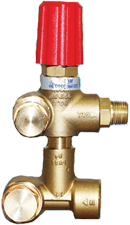
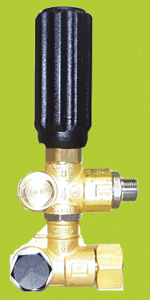
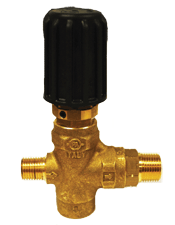
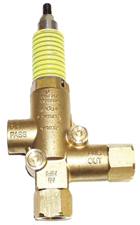
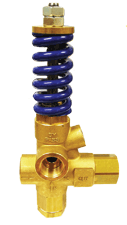
FLOW TYPE UNLOADER VALVE PHOTOS
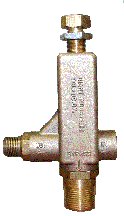
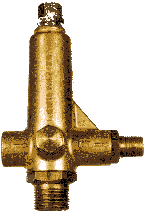
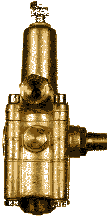
Heaters





FLOW TYPE UNLOADER VALVE PHOTOS



Heaters
Heated power washers open a whole new world of
cleaning, for grease its almost mandatory to have as oil and grease
literally melt away. Hot water can be made with an oil fired burner,
natural gas or propane and most recently with electric heaters. Some
units will take advantage of the 140 degree maximum temperature of most
pumps and pre heat the water then pump it. This is a poor choice as
pump seal life if less than half that of one pumping cold water. The
far better choice is to pump cold water into a high pressure pipe coil
"FIRED" by one of the fuels above.
Originally heater coils and thus their combustion chamber were VERTICAL. It was only natural after all heat rises, in fact so well no insulation was needed to even keep the paint from burning on the coil tank shell. Today "NATURAL ASPIRATED" natural gas and propane fired heaters are still vertical but insulated for efficiency and are the most cost efficient heaters available mostly used in stationary mounted wash bay units with a few portable propane units available. A word on propane when we talk about it we use "pigs" that supply vapor to a building or "Barbecue tanks" for portable units. The BTU requirements of heating 3-5 gallons per minute of water instintaniusly can not be met by "Hi Low" tanks.
Due to it availability the most common heated unit sold by far is the "OIL FIRED" burner. This uses a forced air burner assembly similar to a home heater in rural areas that are quickly fading away. They also were all vertical coil until around the time of the 1970 oil embargo when fuel efficency ws the new catch phrase with even tax credits given if you could prove fuel savings. This led to the design of "HORIZONTAL FIRED" coil units. By laying the coil down and reducing vent stack size these heaters retained more heat nd required insulation to keep the top of the coil tank from glowing cherry red. Today's designs have all but eliminated the efficiency gap and vertical units that take up less floor space are making a come back.
Oil fired heaters originally only burned kerosene or Home Heating Oil and this is the best choice still, however todays burner assemblies operating at higher oil pressure and improved oil nozzles allow the use of more readily available DIESEL FUEL, The trade of is increase maintenance like cleaning the soot off coils. Fuel consumption is between 1.25 gallons per hour for a 2gpm pressure washer up to 3.50 gallons per hour fuel for 6 gpm heaters.
Electric heaters are the relative newcomers mostly due to power requirements and the water and electricity fears of many. You see to heat 4 gallons per minute of water to 200 degrees takes about 90 amps of 460 volt three phase power. Many buildings do not have 3 phase and the size of the power cord needed for that many amps is large. With that said they are the cleanest safest type heater available today and as plants seek elimination of "OPEN FLAME" heaters , vent stacks and smoke and odors in their factories electric heat is taking a strong foothold.
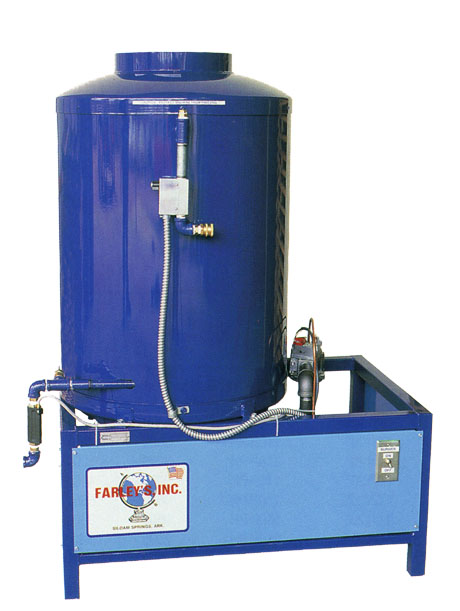
Originally heater coils and thus their combustion chamber were VERTICAL. It was only natural after all heat rises, in fact so well no insulation was needed to even keep the paint from burning on the coil tank shell. Today "NATURAL ASPIRATED" natural gas and propane fired heaters are still vertical but insulated for efficiency and are the most cost efficient heaters available mostly used in stationary mounted wash bay units with a few portable propane units available. A word on propane when we talk about it we use "pigs" that supply vapor to a building or "Barbecue tanks" for portable units. The BTU requirements of heating 3-5 gallons per minute of water instintaniusly can not be met by "Hi Low" tanks.
Due to it availability the most common heated unit sold by far is the "OIL FIRED" burner. This uses a forced air burner assembly similar to a home heater in rural areas that are quickly fading away. They also were all vertical coil until around the time of the 1970 oil embargo when fuel efficency ws the new catch phrase with even tax credits given if you could prove fuel savings. This led to the design of "HORIZONTAL FIRED" coil units. By laying the coil down and reducing vent stack size these heaters retained more heat nd required insulation to keep the top of the coil tank from glowing cherry red. Today's designs have all but eliminated the efficiency gap and vertical units that take up less floor space are making a come back.
Oil fired heaters originally only burned kerosene or Home Heating Oil and this is the best choice still, however todays burner assemblies operating at higher oil pressure and improved oil nozzles allow the use of more readily available DIESEL FUEL, The trade of is increase maintenance like cleaning the soot off coils. Fuel consumption is between 1.25 gallons per hour for a 2gpm pressure washer up to 3.50 gallons per hour fuel for 6 gpm heaters.
Electric heaters are the relative newcomers mostly due to power requirements and the water and electricity fears of many. You see to heat 4 gallons per minute of water to 200 degrees takes about 90 amps of 460 volt three phase power. Many buildings do not have 3 phase and the size of the power cord needed for that many amps is large. With that said they are the cleanest safest type heater available today and as plants seek elimination of "OPEN FLAME" heaters , vent stacks and smoke and odors in their factories electric heat is taking a strong foothold.




